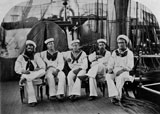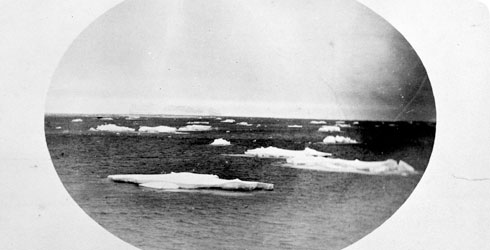Life on board
Many important specimens were discovered on the Challenger voyage, but life on board wasn't easy for the crew at the time.
Entertainment on board
The crew of HMS Challenger had to work hard, but there was also plenty of time for amusement on the long voyage.
The Challenger had its own band to play music and there was an HMS Challenger song. The crew also kept a variety of pets on board including a cassowary, ostriches, tortoises, spiders, a fur seal, and Robert the Parrot, who they bought from a ship docked in Madeira. He survived all the gales and bad weather on the voyage, and used to repeat the phrase 'What? Two thousand fathoms and no bottom!'
The work routine
The crew established a successful sampling routine but, with so many stations to visit, it became repetitive after a while.

A warrior from the Philippines, photographed by the crew of HMS Challenger
Collecting, storing, recording and cataloguing new specimens was tedious work and several of the officers documented their boredom in their personal journals.
Even for most of the scientists aboard, the novelty wore off after the first few tens of stations, and for the crew there was a lot of hard physical work. 61 of them deserted at Challenger’s various ports of call. They may have been put off by the hard work, but were also attracted by the new lands and opportunities that arose because of their work on HMS Challenger.
Collecting on shore
HMS Challenger was in harbour for more than half the days of the voyage. This gave her sailors and scientists a chance to visit ports in North and South America, South Africa, Australia, New Zealand, Hong Kong, Japan, and a series of islands in the Atlantic and Pacific.
During these runs ashore the ship’s officers and scientists made extensive zoological, botanical and ethnographic collections, and met all kinds of people, ranging from the King of Portugal and the Emperor of Japan to natives of Fiji. They were usually well received and entertained, and often returned the invitation.
A new technique

A photograph of sailors on board HMS Challenger
The expedition had an official artist Jean Jacques Wild, sometimes known as John James Wild. He produced many illustrations for the Challenger Report, as well as sketches and colour illustrations of the places they visited.
But many events were also recorded photographically. The Challenger expedition seems to have been the first to routinely use this relatively new technology. The photographer had his own darkroom on board and he sold pictures to members of the crew.
Long exposure times were needed to take photos, so there are no action shots of sailors and scientists working on deck. But there is a superb collection of photographs of groups of people, landscapes and places of interest from many locations. These are of historical importance and include the first known photographs of Antarctic icebergs ever taken. There are also rare photographs of the inhabitants of Tierra del Fuego, in Patagonia, who were eradicated shortly afterwards as western infectious diseases spread in South America.
Toolbox

Our fossil insect collection includes Rhyniognatha hirsti, the world's oldest fossil insect, dating back some 400 million years.
